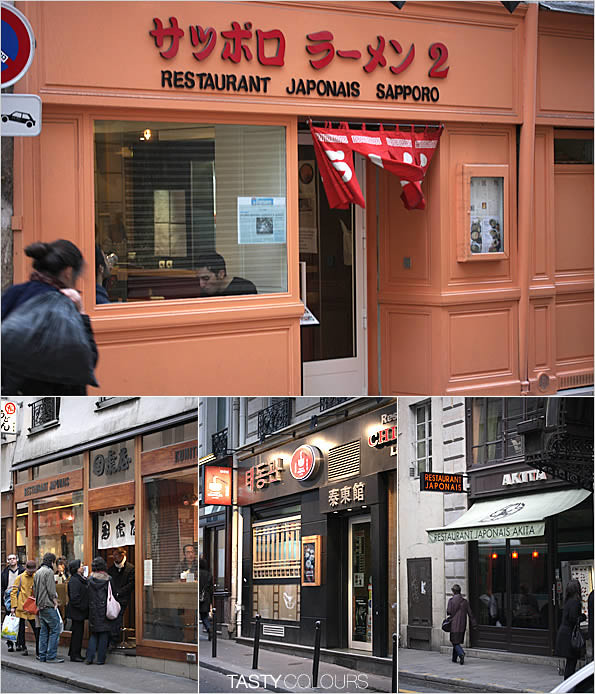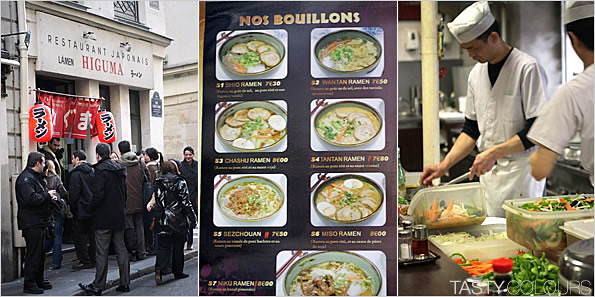Don’t you think that while it is normal for us to cook Indian, Thai, Chinese, French or Italian food at home, we, meaning the people somewhere in continental Europe, very rarely try to make Japanese food…? And if we do, it will most likely be some approximations of sushi or miso? Even when we eat Japanese food in restaurants in Europe, it will most probably be nigiri and maki with the repeated toppings, or perhaps tempura. Who, among you, cook Japanese food at home?
Well, that’s the opinion of Michael Booth. I believe that guy is quite all right. If the name of this food writer does not ring a bell, I remind you that I introduced his previous book on my blog - the one about French cooking. Already a few months ago I found out that in 2009 he had published another book about Japanese cooking. I did not have, however, the occasion to buy this book titled “Sushi and Beyond – what the Japanese Know about Cooking” and to go through it. According to the Guardian’s review, “worried about his own expanding Western waistline, Booth decided to travel across Japan, discovering methodically, greedily the secrets of its national cuisine”. He took his family with him (they insisted on that), but apparently his more important fellow-traveler was a legendary Shizuo Tsuji's seminal Japanese cook book: A Simple Art. The trip included the region of Tokyo, then Hokkaido and Sapporo, Kyoto on Honshu, Kobe, Osaka, Fukuoka and Okinawa. He did not only visit the most renowned foodie places in Japan, but also met chefs and artisanal producers of Japanese specialties, tried authentic – often the best authentic Japanese food, the food that is going “much beyond sushi”. In sum, Michael made a thorough investigation of Japanese food, trying to understand the mystery of longevity and the good health condition of older Japanese – in a nation, which according, to many people and the Japanese themselves, is the most obsessed with eating healthy, local and fresh food in the World.
Booth, using a witty language, began “to appreciate Japanese philosophy and the delicate pageantry of its cuisine”. What he realized as the main difference between European and Japanese cooks, was the attitude to food products. While in France, for example, “chefs want to change the ingredients they cook, putting their individual mark on them, in Japan the ingredients are considered a gift from God that should not be altered too much. "In other words, in Japan, chefs work with what God provides, in France the chefs think they are God."
As regards me, I also was always afraid of preparing Japanese food at home. I have never tried to do sushi, thinking that there were a lot of people doing this better than me. I have, however, some books about Japanese cooking. I have never used them in practice. I always thought that it was too mysterious to me, especially as regards the ingredients (despite the fact that here, in Paris, they are quite easily accessible).
If you want to find out:
· Why customers in food stores in Japan wave their mobile phones to a curious looking bar code;
· How many restaurants are in Tokyo, what is the best Japanese restaurant, how to get there and who was crying there;
· What sumo wrestlers eat for lunch to be so fat (and these are not hamburgers);
· how many food shows are organized in Japan and which American stars visit the most famous food shows;
· Who invented MSG, is MSG really bad for us and what is the link between MSG and umami;
· What is the role of bonito fish in Japanese cooking;
· Why you can eat the whole wasabi root at one shot;
· What is hanging from the ceiling in Taruichi restaurant, famed for its whale meat dishes;
· Where one can eat extraordinary ramen soup and fresh, raw crabs – “so sensuous to the point of perversion”;
· What are the culinary differences between the regions of Japan;
· What is the most exquisite recipe book and why;
· How nagashi-somen taste – wheat noodles which are dropped into fast-flowing mountain rivers and self-served straight from the river;
· Why the consumption of sake declines in Japan?
· What are the origins of sushi (you will be surprised);
· How genuine tofu should taste and why local artisan tofu makers have been going out of business;
· What is the World’s most fascinating food city (and it is not Paris);
· Why miso soup should be served at the end of a meal;
· Whether Kobu cows indeed drink beer, listen to music and have a massage, and why, at least theoretically, the Japanese did not eat meat for ages;
· Where the World’s greatest organic soy sauce is made and how much costs 10-year-old soya sauce?
· What are the best Japanese cooking schools and how much time it takes to become a chef in Japan;
· Where to find the best ramen soup?
· How does the poisoning fish called “fugu” taste;
· What are the myths and truths about eternity of the Okinawans,
· Whether it is possible that Japanese salt lowers blood pressure;
Then just decide to spend 10 Euro and buy Michael’s book. I assure that you will read it in two or three evenings; it is easy to read, witty and funny, and full of reliable information; and despite what was written in the Guardian – that “the extraneous material blurs the book's focus, giving it a casualness which undermines the profundity of Booth's journey. Like good soya sauce, Sushi and Beyond needed a longer distillation period to achieve its true potential” – maybe, yes; but the book is excellent to me.
Right after I finished the book, I felt a bit anxious. I know that there are many restaurants in Paris serving Japanese food (actually around 350). Most of them serve in general sushi, sashimi, yakitori, teriyaki and miso soup. That’s why I went for a walk to the 1st and 2nd arrondissement. Do you know the Opera neighborhood in Paris, quite close to the Seine river?
This is where one can find numerous authentic stores with Japanese ingredients imported straight from Japan. There are also restaurants, serving something more than sushi and sashimi. Apparently, a “little Tokyo”, albeit not officially, exists in Paris. Rue St-Anne and rue des Petits Champs are especially “stuffed” with Japanese food. One will find there tens of restaurants serving for example, variations of ramen, and gyoza – Japanese dumplings.
Basic Japanese ingredients for home cooks may also be found in the Chinese quarter (which is in the 13th arrondissement), in particular in the huge Tang Frères grocery store, but the Opera neighborhood may be definitely described as a Japanese quarter.
The “Kioko Grocery Store” is located 46 rue des Petits Champs. I have heard that the shop is one of the oldest Japanese food stores in Paris. They sell everything what is needed for basic Japanese cooking, meaning various types of noodles, Japanese soya sauce, sea-weeds, rice, mirin, sake, bonito flakes, wasabi powder, rice and so on. When I visited the shop, about 70% of the customers where Japanese. The staff was nice and helpful; however I was not allowed to take pictures (which I did anyway, but from the outside, through the window). In a small Juji-Ya, rue St-Anne, the Japanese staff was even nicer. I could take pictures, maybe because they do not sell so many products. The largest grocery store with Japanese (and Korean) food products - K-Mart, which opened quite recently, is located 6-8 Rue St-Anne. It is also a bit cheaper than Kioko and Juji-Ya. Aside from products such as various types of rice, noodles, sauce soya, rice vinegars, mirin, sakes, beers, dried fish, you will find there a large selection of vegetables and fruits, as well as a counter with freshly cut fresh fish and thin slices of meat. The choice of fresh miso, tofu, shizo leaves and sesame, various types of Japanese and Korean mushrooms is large. The store offers a wide range of frozen foods, like for example, green soya beans or gyoza – Japanese dumplings, Japanese caviar, korokke (Japanese croquets). Additionally, there is a restaurant serving hot dishes.
Grocery stores are one thing. There also is a wide range of tiny Japanese restaurants, serving various foods other than sushi. A lot of these places are packed during lunch time, as they offer nutritious and simple food for reasonable prices.
I recommend visiting, for example, “Higuma” located rue St-Anne. Be careful, however, not to go there at lunch time as the restaurant is awfully packed and that you probably will have to spend 15 minutes (or even more) waiting outside. Once you get there, you can enjoy excellent bowls of burning hot noodles, ramen, gyoza and many other dishes. I met there a very nice Parisian, Thierry, who apparently comes here for lunch nearly every day; he was familiar with waiters and cooks and knew the menu by heart. The interior design is simple but there is a one appealing thing: an open kitchen with counter seats. Fortunately, I was seated with Thierry at such a counter (as we came for lunch alone), so I could enjoy a direct view of chefs cooking ramen soup, Yakisoba, rice, gyoza and so on. The food is not pretentious and is served at very reasonable prices (between 5 and 10 euro). If you do not find any place there, it is not a problem: there are other tiny restaurants, in neighboring buildings, which are also packed.













